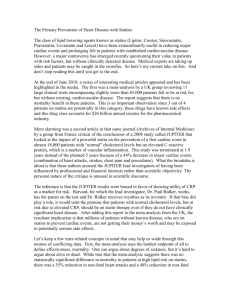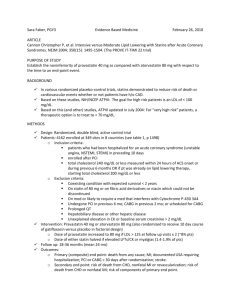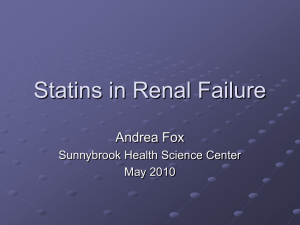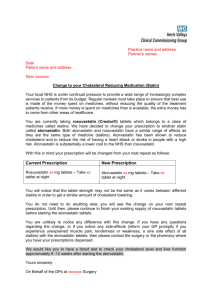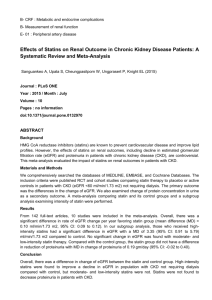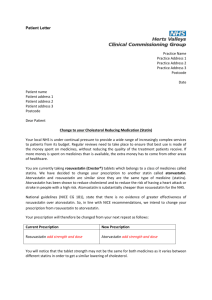Prescribing Statins for Older Adults
advertisement
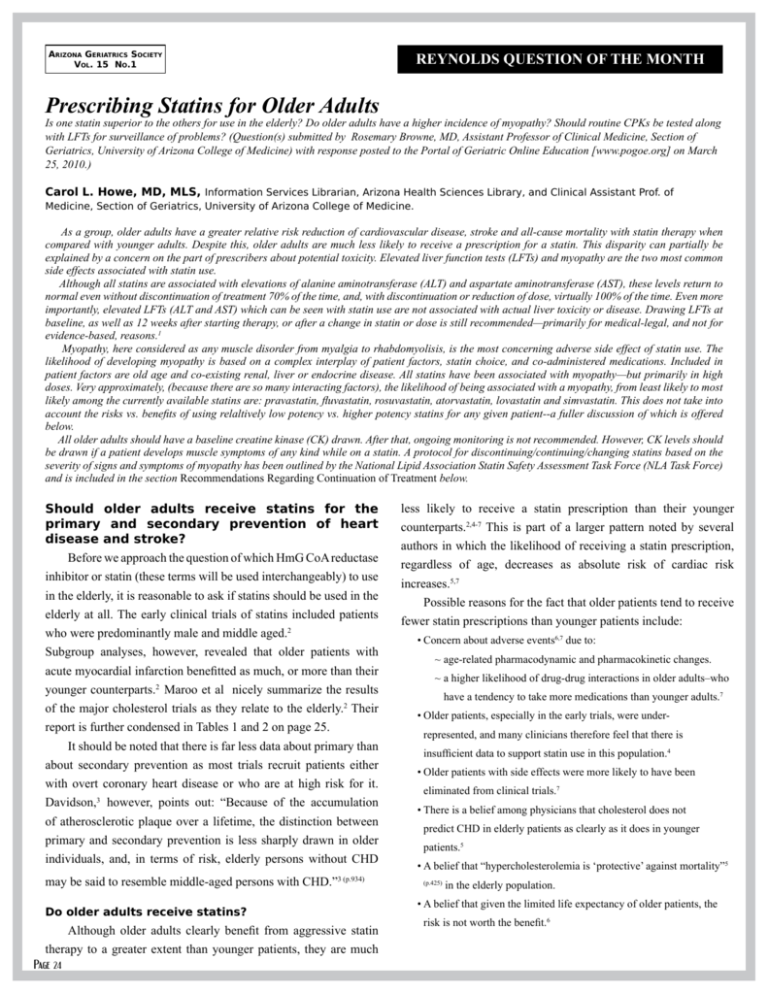
REYNOLDS QUESTION OF THE MONTH Arizona Geriatrics Society Vol. 15 No.1 Prescribing Statins for Older Adults Is one statin superior to the others for use in the elderly? Do older adults have a higher incidence of myopathy? Should routine CPKs be tested along with LFTs for surveillance of problems? (Question(s) submitted by Rosemary Browne, MD, Assistant Professor of Clinical Medicine, Section of Geriatrics, University of Arizona College of Medicine) with response posted to the Portal of Geriatric Online Education [www.pogoe.org] on March 25, 2010.) Carol L. Howe, MD, MLS, Information Services Librarian, Arizona Health Sciences Library, and Clinical Assistant Prof. of Medicine, Section of Geriatrics, University of Arizona College of Medicine. As a group, older adults have a greater relative risk reduction of cardiovascular disease, stroke and all-cause mortality with statin therapy when compared with younger adults. Despite this, older adults are much less likely to receive a prescription for a statin. This disparity can partially be explained by a concern on the part of prescribers about potential toxicity. Elevated liver function tests (LFTs) and myopathy are the two most common side effects associated with statin use. Although all statins are associated with elevations of alanine aminotransferase (ALT) and aspartate aminotransferase (AST), these levels return to normal even without discontinuation of treatment 70% of the time, and, with discontinuation or reduction of dose, virtually 100% of the time. Even more importantly, elevated LFTs (ALT and AST) which can be seen with statin use are not associated with actual liver toxicity or disease. Drawing LFTs at baseline, as well as 12 weeks after starting therapy, or after a change in statin or dose is still recommended—primarily for medical-legal, and not for evidence-based, reasons.1 Myopathy, here considered as any muscle disorder from myalgia to rhabdomyolisis, is the most concerning adverse side effect of statin use. The likelihood of developing myopathy is based on a complex interplay of patient factors, statin choice, and co-administered medications. Included in patient factors are old age and co-existing renal, liver or endocrine disease. All statins have been associated with myopathy—but primarily in high doses. Very approximately, (because there are so many interacting factors), the likelihood of being associated with a myopathy, from least likely to most likely among the currently available statins are: pravastatin, fluvastatin, rosuvastatin, atorvastatin, lovastatin and simvastatin. This does not take into account the risks vs. benefits of using relaltively low potency vs. higher potency statins for any given patient--a fuller discussion of which is offered below. All older adults should have a baseline creatine kinase (CK) drawn. After that, ongoing monitoring is not recommended. However, CK levels should be drawn if a patient develops muscle symptoms of any kind while on a statin. A protocol for discontinuing/continuing/changing statins based on the severity of signs and symptoms of myopathy has been outlined by the National Lipid Association Statin Safety Assessment Task Force (NLA Task Force) and is included in the section Recommendations Regarding Continuation of Treatment below. Should older adults receive statins for the primary and secondary prevention of heart disease and stroke? Before we approach the question of which HmG CoA reductase inhibitor or statin (these terms will be used interchangeably) to use in the elderly, it is reasonable to ask if statins should be used in the elderly at all. The early clinical trials of statins included patients who were predominantly male and middle aged.2 Subgroup analyses, however, revealed that older patients with acute myocardial infarction benefitted as much, or more than their younger counterparts.2 Maroo et al nicely summarize the results of the major cholesterol trials as they relate to the elderly.2 Their report is further condensed in Tables 1 and 2 on page 25. It should be noted that there is far less data about primary than about secondary prevention as most trials recruit patients either with overt coronary heart disease or who are at high risk for it. Davidson,3 however, points out: “Because of the accumulation of atherosclerotic plaque over a lifetime, the distinction between primary and secondary prevention is less sharply drawn in older individuals, and, in terms of risk, elderly persons without CHD may be said to resemble middle-aged persons with CHD.” 3 (p.934) Do older adults receive statins? Although older adults clearly benefit from aggressive statin therapy to a greater extent than younger patients, they are much Page 24 less likely to receive a statin prescription than their younger counterparts.2,4-7 This is part of a larger pattern noted by several authors in which the likelihood of receiving a statin prescription, regardless of age, decreases as absolute risk of cardiac risk increases.5,7 Possible reasons for the fact that older patients tend to receive fewer statin prescriptions than younger patients include: •Concern about adverse events6,7 due to: ~age-related pharmacodynamic and pharmacokinetic changes. ~a higher likelihood of drug-drug interactions in older adults–who have a tendency to take more medications than younger adults.7 •Older patients, especially in the early trials, were under- represented, and many clinicians therefore feel that there is insufficient data to support statin use in this population.4 •Older patients with side effects were more likely to have been eliminated from clinical trials.7 •There is a belief among physicians that cholesterol does not predict CHD in elderly patients as clearly as it does in younger patients.5 •A belief that “hypercholesterolemia is ‘protective’ against mortality”5 (p.425) in the elderly population. •A belief that given the limited life expectancy of older patients, the risk is not worth the benefit.6 Table 1 - Results of Clinical Trials of Stains in Elderly Patients with Acute Myocardial Infarction (AMI) (condensed from Maroo et al2) Conclusions Regarding Statin Use in Elderly Trial 4s (Scandinavian Simvastatin Survival Study) “Absolute risk reduction in patients aged ≥65 years was more than twice that in patients aged <65 years for both total and CHD mortality”2 (p.652) CARE (Cholesterol and Recurrent Events) Trial “...in older patients with AMI and average total cholesterol levels, treatment with pravastatin resulted in clinically important risk reductions in major CHD events and stroke. Again, because the CVD event rate is high in this group of older patients, the benefit for this age group is increased.”2 (p.652) LIPID (Long Term Intervention with Pravastatin in Ischemic Disease) Trial Pravastatin reduced total mortality, death from CHD, CHD death or non-fatal MI and MI and also reduced need for revascularization procedures. “The NNT was significantly lower in the elderly subgroup than in younger patients.”2 (p.652) PPPP (Prospective Pravastatin Pooling Project) Meta-analysis of the 4843 elderly patients enrolled in three studies—WOSCOPS (the West of Scotland Coronary Prevention Study, the LIPD and the CARE study.” ...the elderly benefit equally from pravastatin therapy compared with younger patients in the secondary prevention of CHD events.”2 (p.654) “Although the reduction in major CVD events was not significant during the first year of treatment, it was significant HPS during each subsequent year.”2 (p.654) Of the 20,356 adults in this (Heart Protection Study) study, 10,697 were over 65. Results were similar across all age groups. PROSPER (Prospective Study of Pravastatin in the Elderly at Risk) First study with exclusively elderly population and results similar to all above studies, suggesting “that target elderly patients at high risk for vascular events with statin therapy is justified for primary and secondary CVD prevention.”2 (p.654) Table 2-Results of Clinical Trials of Intensive Statin Therapy Stains in Elderly Patients with Coronary Heart Disease (CHD) (condensed from Maroo et al2) Trial Conclusions Regarding Statin Use in Elderly MIRACL (Myocardial Ischemia reduction with Acute Cholesterol Lowering) Trial Trial of 3086 patients whose mean age was 65—but in which no specific subgroup analysis of elderly patients was done. Researchers found “a nonstatistically significant trend to lower incidence of death, non-fatal MI and cardiac arrest”2 (p.655) in patients treated with 80 mg of atorvastatin vs placebo. 4162 patients with Acute Coronary Syndrome (ACS) randomized PROVE IT-TIMI 22 to either pravastatin 40 mg/day or atorvastatin 80 mg/day (Pravastatin or Atorvastatin within 10 days of presentation. Subgroup analysis of elderly Evaluation and Infection patients indicates “that elderly patients derive greater absolute Therapy-Thrombolysis in and relative benefit from intensive lipid lowering in ACS, Myocardial Infarction 22) with a similar adverse effect profile to younger patients.”2 (p.655) A to Z Trial Compared aggressive with conservative therapy (patients with ACS randomized to either Simvastatin 40 mg/day for 1 month and then 80 mg/day vs placebo for 4 months and then Simvastatin 20 mg/day). Although aggressive treatment resulted in reaching cholesterol goal less than 70 mg/dL, there was no reduction in CVD death, MI, readmission for ACS or stroke at 1 and 4 months. At 2 years, CVD death was reduced by 25% in aggressive arm. SAGE (Study Assessing Goals in the Elderly) Compared 893 ambulatory elderly patients with stable CHD who were randomized to receive 80 mg of atorvastatin with 40 mg of pravastatin. High dose atorvastatin reduced CVD mortality rate more than standard dose pravastatin without an increase in adverse events. Page 25 Which statin is appropriate for my patient? It is clear that multiple studies support the use of statin therapy in elderly patients with, or at risk for, heart disease. How should a clinician choose which statin to use? Before proceeding, a brief discussion reviewing the distinguishing pharmacological features of statins is warranted. In the United States there are presently six statins available: lovastatin (Mevacor), pravastatin (Pravachol) and simvastatin (Zocor) — all available generically and by brand name; and atorvastatin (Lipitor), lovastatin (Mevacor), and rosuvastatin (Crestor) which are available by brand name only. Potency and Pleiotropism In general, rosuvastatin, atorvastatin and simvastatin are considered to be the most potent statins and fluvastatin, pravastatin and lovastatin less potent. Some authors, however, place simvastatin among the less potent group and pravastatin in the more potent group.8 The variation in opinion may be due to whether one is measuring potency by effect on lipid profile, or by clinical effectiveness in reducing heart disease and stroke, the two end-points not necessarily being one and the same. Statins have been found to have coronary heart disease and stroke lowering capabilities which do not directly correlate either with their LDL lowering or their HDL raising effects. Simvastatin, for example, in the A to Z trial2 did not result in as dramatic a clinical event reduction as did “high-dose atorvastatin in MIRACL and PROVE IT-TIMI 22 despite achievement of similar levels of LDL cholesterol.”2(p.661) The mechanisms by which statins exert clinical benefit beyond those which can be attributed to their lipid lowering effect are not fully understood. Hypotheses include “stabilization of plaque, improvement of endothelial dysfunction, reduced inflammation and decreased thrombogenicity (collectively known as pleiotropic effects.”2 (p. 655) In recognition of the pleiotropic effects of at least one statin,rosuvastatin, the FDA, in February of 2010, approved its use for men aged 50 and over and women aged 60 and over with an elevated (> 2 mg/L) C-reactive protein (CRP) and at least one other cardiovascular risk factor, but not necessarily an elevated cholesterol or abnormal lipid profile.9 Rosuvastatin is the most potent statin and has the longest half-life.5 While high doses may therefore lead to greater toxicity than equivalent doses of other statins, relatively low doses can be effective in bringing patients to their cholesterol goal and in positively impacting clinical outcomes. Factoring in its low incidence of adverse effects and relatively low rate of drug-drug interactions further raises the potential usefulness of rosuvastatin for use in older adults, as will be further elucidated below. Lipophilicity vs. Hydrophilicity Page Lipophilic statins penetrate muscle more easily than 26 hydrophilic statins and are associated with a higher incidence of adverse effects, particularly myopathy, although reports of muscle toxicity, including rhabdomyolisis have been reported with all statins.1 Simvastatin is the most lipophilic statin.5 Other lipophilic statins are lovastatin and atorvastatin. Hydrophilic statins include pravastatin and fluvastatin. Rosuvastatin is “relatively hydrophilic.”3(p.139) Although hydrophilic statins have a lower association with adverse effects, they generally require higher dosing to be efficacious—with the exception of rosuvastin.3 Higher doses, in turn, may be associated with adverse effects. Protein-binding Protein binding also plays a role in the potential for adverse effects of statins. Statins other than pravastatin are highly protein bound. Decreases in serum protein levels, often seen in frail older adults may result in higher concentrations—and higher toxicity.5 Cytochrome P450 and Drug-Drug Interactions Pravastatin, fluvastatin and rosuvastatin, the hydrophilic statins, are also the three statins not metabolized by the Cytochrome P450 3A4 enzyme (CYP3A4), though fluvastatin and, to a lesser extent, rosuvastatin, which is largely excreted unchanged,3 are metabolized by CYP2C9. Pravastatin is not metabolized by the Cytochrome P450 system at all and has the lowest risk of drug-drug interactions of all the statins.2 All in all, pravastatin, fluvastatin and rosuvastatin are much less likely than their lipophilic, CYP3A4 metabolized, cousins to be involved in drug-drug interactions.10,11 Of the statins which are metabolized by CYP3A4, lovastatin and simvastatin are considered “‘sensitive substrates’ because their levels may be increased five-fold or higher by CYP3A4 Inhibitors.”12 Atorvastatin, also metabolized by CYP3A4, interacts with CYP3A4 inhibitors to a lesser extent. The medications most likely to affect statin metabolism and thereby increase the risk of adverse effects such as myopathy include, but are not limited to: amiodarone; fluconazole, ketoconazole and other azole anti-fungals; the non-dihydropyridine calcium channel blockers-diltiazem and verapamil; cyclosporine; danazol; the anti-arrhythmic dronedarone; erythromycin and other macrolide antibiotics; nefazodone; phenytoin; and the protease inhibitors. Grapefruit juice also inhibits CYP3A4 and can potentiate statin myotoxicity.10,12 The potential for toxicity works both ways. Statins coadministered with warfarin can result in elevated INRs. They can also contribute to phenytoin and digoxin toxicity when given with these medications.12 Adverse Effects and Recommendations for Monitoring While statins as a class of drugs are generally safe, they are associated with two primary types of adverse effects: asymptomatic elevation of liver enzymes, and myopathies. There is no evidence that the incidence of these two side effects are associated with each other; that is, patients with elevations of liver enzymes are not more likely to experience myopathies, or vice versa.8 Elevation of liver enzymes All statins are associated with elevations of alanine aminotransferase (ALT) and aspartate aminotransferase (AST) up to three times the upper limit of normal. Even without discontinuing the statin or lowering the dose, 70% of patients with such elevations will experience a return to normal levels. For patients with persistent elevations of liver enzymes, discontinuation or lowering the statin dose almost always effects a return of liver enzyme levels to normal.1 Even more importantly, there has been no link between statin associated elevation of liver enzymes and actual liver toxicity or disease. In the “Final Conclusions and Recommendations of the National Lipid Association Statin Safety Assessment Task Force [NLA Task Force],”1 the authors note that the rate of liver failure in the general population is about the same as among those taking statins. Monitoring Liver Enzymes The NLA Task Force states that there is “no evidence to support the continued monitoring of liver function tests in patients receiving statin therapy.”1(p. 90C) For medical-legal reasons, however they recommend that clinicians continue to “measure transaminase levels before starting therapy, 12 weeks after initiating therapy, after a dose increase, and periodically thereafter.”1(p. 90C) These recommendations apply to routine screening and the Task Force emphasizes that any clinical signs and symptoms such as jaundice, malaise, or hepatomegaly be thoroughly investigated. Myopathy Myopathy is the most common side effect associated with the use of statins and, since the withdrawal of cerivastatin (Baycol) from the market in 2001 after its use resulted in a large number of cases of rhabdomyolisis, myopathy is also the side effect of most concern to clinicians. Definitions of the term myopathy vary. The NLA Task Force includes the following in its definition: “the presence of muscle pain, soreness, weakness, and/or cramps plus a CK [creatine kinase level 10 times the ULN [upper limit of normal].”1(p. 91C) They define rhabdomyolisis as consisting of the presence of a CK greater than 10,000 IU/L or a CK greater than 10 X the ULN plus an elevation in serum creatinine or medical intervention with IV hydration therapy.”1( p. 92C) By contrast, the ACC/AHA/NHLBI Clinical Advisory on the Use and Safety of Statins offers the following definitions: Myopathy—a general term referring to any disease of muscles; myopathies can be acquired or inherited and can occur at birth or later in life. Myalgia—muscle ache or weakness without creatine kinase (CK) elevation. Myositis—muscle symptoms with increased CK levels. Rhabdomyolysis— muscle symptoms with marked CK elevation (typically substantially greater than 10 times the upper limit of normal [ULN]) and with creatinine elevation (usually with brown urine and urinary myoglobin).13(p.567) For the purposes of this review, myopathy is used in this more general sense of any muscle-related disorder. Risk Factors for Developing Statin-Associated Myopathy Older age, along with small size, female gender, preexisting liver, renal or endocrine disease are all patient-dependent risks for statin induced myopathy.5,12 Although the mechanism by which statins cause muscle toxicity are not understood, there is some thought that age associated decreases in muscle mass may contribute to its increased incidence in the elderly.3 Any statin can cause any muscle symptom — from mild myalgias to rhabdomyolisis. Fluvastatin and pravastatin, two relatively low potency statins that are not metabolized by CYP3A4, carry the lowest risk of rhabdomyolisis; high dose simvastatin (80 mg) carries the highest risk.1,2 The probability of muscle toxicity in general increases with increasing doses of statins, and serious side effects are rare at lower doses. Along with high dosing, drug-drug interactivity highly impacts the myopathic potential of statins. When statins which are metabolized by CYP3A4 (atorvastatin, lovastatin, and simvastatin), are given with CYP3A4 inhibitors, their metabolism is decreased, and the potential for toxicity increases. Atorvastatin is less affected by CYP3A4 inhibitors than lovastatin or simvastatin.12 Please refer to the section Cytochrome P450 and Drug-Drug Interactions above for details about specific medications. In addition to CYP3A4 effects, the risk for myopathy is also compounded when statins are given with other medications which cause myopathy. (Cyclosporin and danazol fit into this category as well as being CYP3A4 inhibitors.) In efforts to synergize lipid lowering effects, non-statin lipid lowering agents are often co-administered with statins. Unfortunately some of these medications such as niacin and fibric acid derivatives also cause myopathy—fenofibrate less so than gemfibrozil.12 Conversely, the effectiveness of statins can be decreased by when given with bile acid sequestrants such as cholestyramine and colestipol, because of intestinal binding.12 Alcohol overuse is also associated with an increased incidence of myopathy—both independently and in combination with statins.13,14 The HMG-CoA reductase inhibitor, cerivastatin (Baycol) Page 27 was on the market from 1997 until August of 2001 when it was voluntarily withdrawn by Bayer A.G. after it was found to have caused 52 fatal and 385 nonfatal cases of rhabdomyolisis.11,13 Not only did cerivastatin have a very high potential for drug-drug interactions, but it was promoted for use at very high doses. It was especially toxic when prescribed with a second lipid lowering drug, gemfibrozil.13 The authors of the NLA Task Force1 stress, as do many other authorities, that none of the currently marketed statins possess the unfavorable combination of pharmacological features which made cerivastatin so toxic. It can be seen that the potential for toxicity, specifically myotoxicity, “arguably the most prevalent and important adverse effect associated with statin therapy,”1(p. 90C) is a complex mixture of many interacting factors, including patient factors, statin-specific factors, and number and type of co-administered medications. That being said, an approximation of potential for causing myopathy among the currently available statins, based on various pharmacological attributes is, from least likely to be associated with myopathy to most likely: pravastatin, fluvastatin, rosuvastatin, atorvastatin, lovastatin and simvastatin. Although it might be tempting to therefore reach for pravastatin or fluvastatin for all older patients, especially those with comorbidities and taking multiple medications, the potential benefit of, for example, using a high potency statin vs. a low potency one, must always be factored into the decision. The SAGE trial15 for example, which specifically studied older adults aged 65-85 with CAD, was designed to compare moderate lipid lowering therapy (pravastatin 40 mg daily) with intensive therapy (atorvastatin 80 mg daily.) The researchers found fewer major acute cardiovascular events and significantly fewer deaths from any cause in the intensively treated group. Recommendations Regarding Continuation of Treatment When Patients Develop Myopathy: The NLA Task Force recommends the following: •“In patients who develop intolerable muscle symptoms with or without a CK elevation and in whom other etiologies have been ruled out, the statin should be discontinued. Once asymptomatic, the same or different statin at the same or lower dose can be restarted to test the reproducibility of symptoms. Recurrence of symptoms with multiple statins and doses requires initiation of other lipid-altering therapy.” 1(p. 92C, Table 3) •“In patients who develop tolerable muscle complaints or are asymptomatic with a CK <10X the ULN, statin therapy may be continued at the same or reduced doses and symptoms may be used as the clinical guide to stop or continue therapy.”1(p. 92C, Table 3) •“In patients who develop rhabdomyolisis (a CK >10,000 IU/L or a CK >10 times the ULN with an elevation in serum creatinine or requiring IV hydration therapy), statin therapy should be stopped. IV hydration therapy in a hospital setting should be instituted if indicated for patients experiencing rhabdomyolisis. Once recovered, the risk vs. benefit of statin therapy should be carefully reconsidered.1(p. 92C, Table 3) Anecdotal Alternatives In patients without severe symptoms for whom continuation of statins would be clinically beneficial, suggestions, all of which are supported by anecdotal evidence only, include: •Recommending coenzyme Q10, 100 mg once to three times a day (there are conflicting reports about the true efficacy of this treatment).12 •Trying very low doses of rosuvastatin such as 2.5 mg-20 mg Monitoring for Myopathy once weekly or other variations such as 2.5-10 mg two to The NLA Task Force recommends drawing a baseline CK level in patients at high risk for muscle toxicity, which includes older patients and in those patients who may be taking a concomitant medication associated with increasing the risk for myopathy.12 The Adult Treatment Panel III (ATP III) of the National Cholesterol Education Program (NCEP) recommends universal baseline CK measurements to aid decision making should a problem occur during the course of treatment.13 Ongoing monitoring is generally not recommended for asymptomatic patients. Incidental findings of increased CK are often associated with exercise or exertion. CK levels should be obtained for patients who develop muscle symptoms of any kind during the course of their treatment with statins. The ACC/AHA/NHLBI Task Force also recommends drawing a thyroid stimulating hormone (TSH) level in all patients with new onset of muscle pain because of the association of hypothyroidism with myopathy.13 three times weekly.12 Page 28 •Pulse dosing of statins with regimens such as four weeks on and two weeks off.12 •Vitamin D supplementation. This may be especially beneficial for patients with myopathy who are found to have low Vitamin D levels. After correcting with Vitamin D supplementation a significant percentage of patients in a small study of 11 patients were able to tolerate statin rechallenge.16 Statins in the Acute Setting The risk of statin-associated myopathy is increased in perioperative settings. Therefore, in non-cardiac, non-stroke patients, consideration may be given to temporarily discontinuing statins in those settings. Also,( in patients who are very stable) if it is felt, to take one example, that a macrolide antibiotic is the necessary treatment, stopping statins for up to six weeks to allow for that treatment may be acceptable.12 In patients who are cardiovascularly unstable, however, the risk caused by stopping statins is greatly increased. Discontinuing statins in patients with acute myocardial infarction or with acute ischemic stroke has been shown to lead to increased rates of poorer outcomes and death, and should be avoided unless very clearly indicated.12 11. Szadkowska I, Stanczyk A, Aronow WS, et al. Statin therapy in the elderly: a review. Arch Gerontol Geriatr. 2010;50(1):114-118. 12. Cinically significant statin drug interactions. Pharmacist’s Letter/Prescriber’s Letter. 2009;25(8):250812.C. 13. Pasternak RC, Smith SC,Jr, Bairey-Merz CN, et al. ACC/AHA/NHLBI clinical advisory on the use and safety of statins. J Am Coll Cardiol. Conclusion lder adults with coronary or cerebral artery disease or risk O factors have the potential to benefit greatly from statin therapy, including aggressive therapy. Concern about the possibility of inducing adverse effects has prevented many prescribers from using this class of medications to its full advantage in patients 65 and over. Balancing patient factors with statin-specific properties and concomitantly given medications is not as complex as it might first appear and guidelines for monitoring and adjusting treatment as necessary exist—all of which should help clinicians maximize the benefit of this potentially life-saving drug class while minimizing the risk for causing harm. 2002;40(3):567-572. 14. Venero CV, Thompson PD. Managing statin myopathy. Endocrinol Metab Clin North Am. 2009;38(1):121-136. 15. Deedwania P, Stone PH, Bairey Merz CN, et al. Effects of intensive versus moderate lipid-lowering therapy on myocardial ischemia in older patients with coronary heart disease: results of the Study Assessing Goals in the Elderly (SAGE). Circulation. 2007;115(6):700-707. 16. Lee P, Greenfield JR, Campbell LV. Vitamin D insufficiency--a novel mechanism of statin-induced myalgia? Clin Endocrinol (Oxf). 2009;71(1):154-5. References 1. McKenney JM, Davidson MH, Jacobson TA, Guyton JR. National Lipid Association Statin Safety Assessment Task Force. Final conclusions and recommendations of the National Lipid Association Statin Safety Assessment Task Force. Am J Cardiol. 2006;97(8A):89C-94C. 2. Maroo BP, Lavie CJ, Milani RV. Secondary prevention of coronary heart disease in elderly patients following myocardial infarction: are all HMG-CoA reductase inhibitors alike? Drugs Aging. 2008;25(8):649-664. 3. Davidson MH. Rosuvastatin in elderly patients. Drugs Aging. 2007;24(11):933-944. 4. Allen Maycock CA, Muhlestein JB, Horne BD, et al. Statin therapy is associated with reduced mortality across all age groups of individuals with significant coronary disease, including very elderly patients. J Am Coll Cardiol. 2002;40(10):1777-1785. 5. Jacobson TA. Overcoming ‘ageism’ bias in the treatment of hypercholesterolaemia : a review of safety issues with statins in the elderly. Drug Saf. 2006;29(5):421-448. 6. Roberts CG, Guallar E, Rodriguez A. Efficacy and safety of statin monotherapy in older adults: a meta-analysis. J Gerontol A Biol Sci Med Sci. 2007;62(8):879-887. 7. Alexander KP, Blazing MA, Rosenson RS, et al. Management of hyperlipidemia in older adults. J Cardiovasc Pharmacol Ther. 2009;14(1):49-58. 8. Corsini A. The safety of HMG-CoA reductase inhibitors in special populations at high cardiovascular risk. Cardiovasc Drugs Ther. 2003;17(3):265-285. 9. Questions and Answers for Healthcare Professionals: CRESTOR and the JUPITER Trial. http://www.fda.gov/Drugs/DrugSafety/ PostmarketDrugSafetyInformationforPatientsandProviders/ucm199891.htm. AccessedMarch 16, 2010. 10. Nair AP, Darrow B. Lipid management in the geriatric patient. Endocrinol Metab Clin North Am. 2009;38(1):185-206. Page 29
